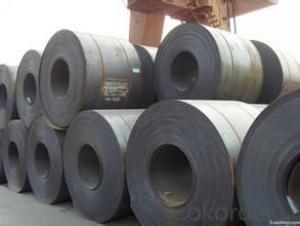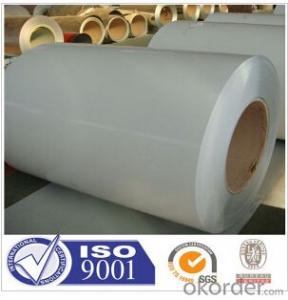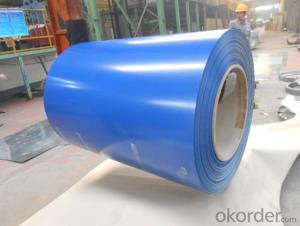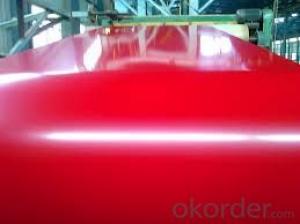PPGI Color Coated Galvanized Steel Coil in Prime Blue Color
- Loading Port:
- Shanghai
- Payment Terms:
- TT OR LC
- Min Order Qty:
- 200 m.t.
- Supply Capability:
- 10000 m.t./month
OKorder Service Pledge
OKorder Financial Service
You Might Also Like
1. Pre-Painted Galvanized/Aluzinc Steel Coil Description:
With GI as base material, after pretreatment (degrease and chemical treatment ) and liquid dope with several layers of color, then after firing and cooling, finally the plate steel is called pre-painted galvanized (aluzinc) steel. Pre-painted galvanized steel is good capable of decoration, molding, corrosion resistance. It generally displays superior workability, durability and weather resistance.
2.Main Features of the Pre-Painted Galvanized/Aluzinc Steel Coil:
• Excellent process capability
• Smooth and flat surface
• Workability, durability
• Excellent heat resistance performance
• High strength
• Good formability
• Good visual effect
3.Pre-Painted Galvanized/Aluzinc Steel Coil Images

4.Pre-Painted Galvanized/Aluzinc Steel Coil Specification
Standard: AISI, ASTM, BS, DIN, GB, JIS
Grade: DX51D, DX52D
Thickness: 0.17-2.0mm
Brand Name: KMRLON
Model Number: coil
Type: Steel Coil
Technique: Cold Rolled
Surface Treatment: Coated
Application: Boiler Plate
Special Use: High-strength Steel Plate
Width: 20-1250mm
Length: customized
commoidty: pre-painted galvanized steel coil
Thickness: 0.13-4.0mm
width: 20-1250mm
zinc coating: 40-180g/m2
printing thickness: top side: 20+/-5 microns, back side: 5-7 microns
color: all RAL color
surface treatment: color coated
coil weight: 4-7 tons
coil ID: 508/610mm
packaging: standard seaworthy packing
5.FAQ of Pre-Painted Galvanized/Aluzinc Steel Coil
1. What’s the application of this product?
Roof, roof structure, surface sheet of balcony, frame of window, etc.
2. What’s the brand of the paint?
We use the best brand of all of the word—AKZO.
3. How to guarantee the quality of the products?
We have established the international advanced quality management system,every link from raw material to final product we have strict quality test;We resolutely put an end to unqualified products flowing into the market. At the same time, we will provide necessary follow-up service assurance.
4. How long can we receive the product after purchase?
Usually within thirty working days after receiving buyer’s advance payment or LC. We will arrange the factory manufacturing as soon as possible. The cargo readiness usually takes 15-25 days, but the shipment will depend on the vessel situation.
- Q: I need to know where to go online to buy a steel cage for a wrestling ring.. Somebody please assist me?
- Steel cages are made from scrap. From either loose metal or loose chains. There might be some on eBay that would be man-made
- Q: What are the different methods of transporting steel coils?
- There are several methods of transporting steel coils, depending on factors such as the weight, size, and distance of the shipment. Some of the different methods include: 1. Flatbed trucks: Steel coils can be transported on flatbed trucks, which have a large open platform for easy loading and unloading. This method is commonly used for short to medium distance shipments and allows for easy access to the coils. 2. Rail transport: Steel coils can also be transported via rail. Specialized railcars called coil cars are used for this purpose, which have a curved interior to securely hold the coils in place. Rail transport is often used for long-distance shipments, as it is cost-effective and can handle large quantities of steel coils. 3. Shipping containers: Steel coils can be loaded into shipping containers for transportation via sea or inland waterways. The coils are usually secured inside the container using bracing or blocking materials to prevent movement during transit. This method is commonly used for international shipments and allows for easy handling and transfer between different modes of transportation. 4. Barges: In certain cases, steel coils can be transported on barges along rivers, canals, or other inland waterways. Barges are often used for large and heavy shipments, as they offer a cost-effective and efficient mode of transportation. 5. Roll-on/roll-off (RoRo) vessels: RoRo vessels are specialized ships designed to transport vehicles and large cargo that can be rolled on and off the ship. Steel coils can be loaded onto trailers or flatbeds and driven onto the vessel, making it a convenient method for transportation. 6. Air freight: While not as common due to cost considerations, steel coils can also be transported by air. This method is typically used for urgent and time-sensitive shipments, or when the distance is too great for other modes of transportation. Air freight offers the advantage of speed and can be a viable option for certain situations. Overall, the choice of transportation method for steel coils depends on various factors such as cost, distance, time frame, and logistical requirements. Freight forwarders and logistics providers can help determine the most suitable method for a specific shipment.
- Q: How are steel coils recycled?
- Steel coils can be recycled through a process that involves melting them down in a furnace, removing impurities, and then shaping the molten steel into new coils or other steel products. This recycling method helps conserve resources, reduce waste, and significantly cut down on energy consumption compared to producing steel from raw materials.
- Q: How to solve steel plate storage
- Avoid steel plates touching the ground, fixing steel coils, and using pads to reduce accidental or dangerous movement.
- Q: What are the surface treatments for steel coils?
- Some common surface treatments for steel coils include galvanizing, painting, and coating. These treatments are applied to protect the steel from corrosion, improve its appearance, and enhance its durability.
- Q: Can steel and/or stainless steel turn rusty ?
- from wikipedia: In metallurgy, stainless steel, also known as inox steel or inox from French inoxydable, is defined as a steel alloy with a minimum of 10.5% to 11% chromium content by mass. Stainless steel does not corrode, rust or stain with water as ordinary steel does, but despite the name it is not fully stain-proof, most notably under low oxygen, high salinity, or poor circulation environments. It is also called corrosion-resistant steel or CRES when the alloy type and grade are not detailed, particularly in the aviation industry. There are different grades and surface finishes of stainless steel to suit the environment the alloy must endure. Stainless steel is used where both the properties of steel and resistance to corrosion are required. Stainless steel differs from carbon steel by the amount of chromium present. Unprotected carbon steel rusts readily when exposed to air and moisture. This iron oxide film (the rust) is active and accelerates corrosion by forming more iron oxide, and due to the dissimilar size of the iron and iron oxide molecules (iron oxide is larger) these tend to flake and fall away. Stainless steels contain sufficient chromium to form a passive film of chromium oxide, which prevents further surface corrosion and blocks corrosion from spreading into the metal's internal structure, and due to the similar size of the steel and oxide molecules they bond very strongly and remain attached to the surface.
- Q: What are the advantages of using steel coils?
- There are several advantages of using steel coils. Firstly, steel coils are highly durable and can withstand extreme conditions, making them suitable for various applications. Secondly, they provide excellent strength and stability, making them ideal for structural purposes. Additionally, steel coils can be easily molded into different shapes, allowing for customization and versatility in design. Moreover, steel coils have a high recycling rate, making them an environmentally friendly choice. Finally, steel coils offer cost-effectiveness due to their long lifespan and low maintenance requirements.
- Q: How do steel coils contribute to energy efficiency in lighting?
- Steel coils do not directly contribute to energy efficiency in lighting. Steel coils are typically used in the manufacturing of various electrical and electronic appliances, including lighting fixtures. However, the energy efficiency in lighting primarily depends on the type of light source used. The energy efficiency of lighting is typically determined by the type of light bulb or fixture used, such as incandescent, fluorescent, LED, or halogen. Each of these light sources has different energy consumption characteristics. Steel coils, on the other hand, are primarily used for structural support, heat dissipation, and protection in lighting fixtures. They are not directly involved in the energy efficiency of the lighting system. However, steel coils can indirectly contribute to energy efficiency in lighting by providing strong and durable support to the lighting fixtures. This allows for reliable and long-lasting installations, minimizing the need for frequent maintenance and replacements. A well-supported lighting system ensures optimal performance and reduces any energy wastage or inefficiencies that may arise from loose or unstable fixtures. Additionally, steel coils can also be utilized in the manufacturing of reflectors or housings for lighting fixtures, which can help enhance the overall efficiency and distribution of light. By effectively reflecting and directing the light output, the utilization of energy and illumination can be optimized, reducing any potential energy waste. While steel coils themselves do not directly impact the energy efficiency of lighting, their use in the construction and support of lighting fixtures can indirectly contribute to a more energy-efficient lighting system.
- Q: I have a job where I'm required to wear ANSI certified steel toed boots or shoes(so long as its ANSI). Thing is, I'm a vegan. I do NOT want to buy leather, and I will go to great lengths to buy a non leather shoe/boot I can wear on the job! I AM currently borrowing my dad's leather ANSI boots, but would very much love to be able to rock a pair of cruelty free boots/shoes on the job!It does not have to be certified vegan just all man-made materials and no leather/sued and other such stuff where animals have to die. It would make me no better than the massive slaughterhouse industries and such. Valueing money of ver live/morals. I don't want one of the first things I need to do in my manufacturing job is compromising my morals. :3So if you know of an ANSI vegan friendly boot brand PLEASE TELL ME! *gets on knees begging*Money isn't really an option for me, I'll just continue borrowing my dad's boots till I save up enough!Thanks in advance! :D
- Vegan okorder /... I don't know if they're ANSI shoes, so you might want to ask.
- Q: Are steel-capped boots safer than non-capped ones when working with horses? I have been told that sometimes if a horse steps on you, the steel crushing into your foot is more dangerous than if you just had normal wellies on, as at least with normal wellies there is some flexibility. Any horsey people out there got any experience with this? Thanks!
- Hey Bunny:) Glad you asked! I know of no one ,at all,that thinks steel toes are better than good reflexes and the ability to move faster! Wellies give flex,Sport shoes give speed, Jods(Paddocks) are the work boot of choice..and if there is one thing we know about horses, nothing happens in slo-mo! There is a fiberglass toe protector a person could use.. I guess..not this person though. Added to the factor that they have that bumpy sole not suited for riding, and a bad heel, and are just plain too heavy. And ankles! nothing special there. My flatmate(roomie) is an Equine reproduction Vet and a Polo Player, and no-one there has anything but jods and wellies. No clunky boots please:) Come to think of it, its been years since Ive mashed a foolish toe..and that takes into account trailering vetting and young-stock work....Yes I vote for movement over safety ** there are no horse-goods for sale with toe caps ** Three cheers for mobility bunny! (and wellies disinfect real nice too)
Send your message to us
PPGI Color Coated Galvanized Steel Coil in Prime Blue Color
- Loading Port:
- Shanghai
- Payment Terms:
- TT OR LC
- Min Order Qty:
- 200 m.t.
- Supply Capability:
- 10000 m.t./month
OKorder Service Pledge
OKorder Financial Service
Similar products
Hot products
Hot Searches
Related keywords




























